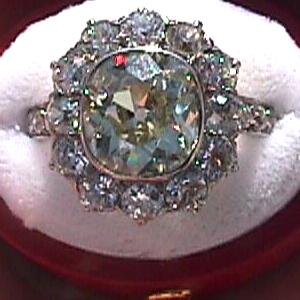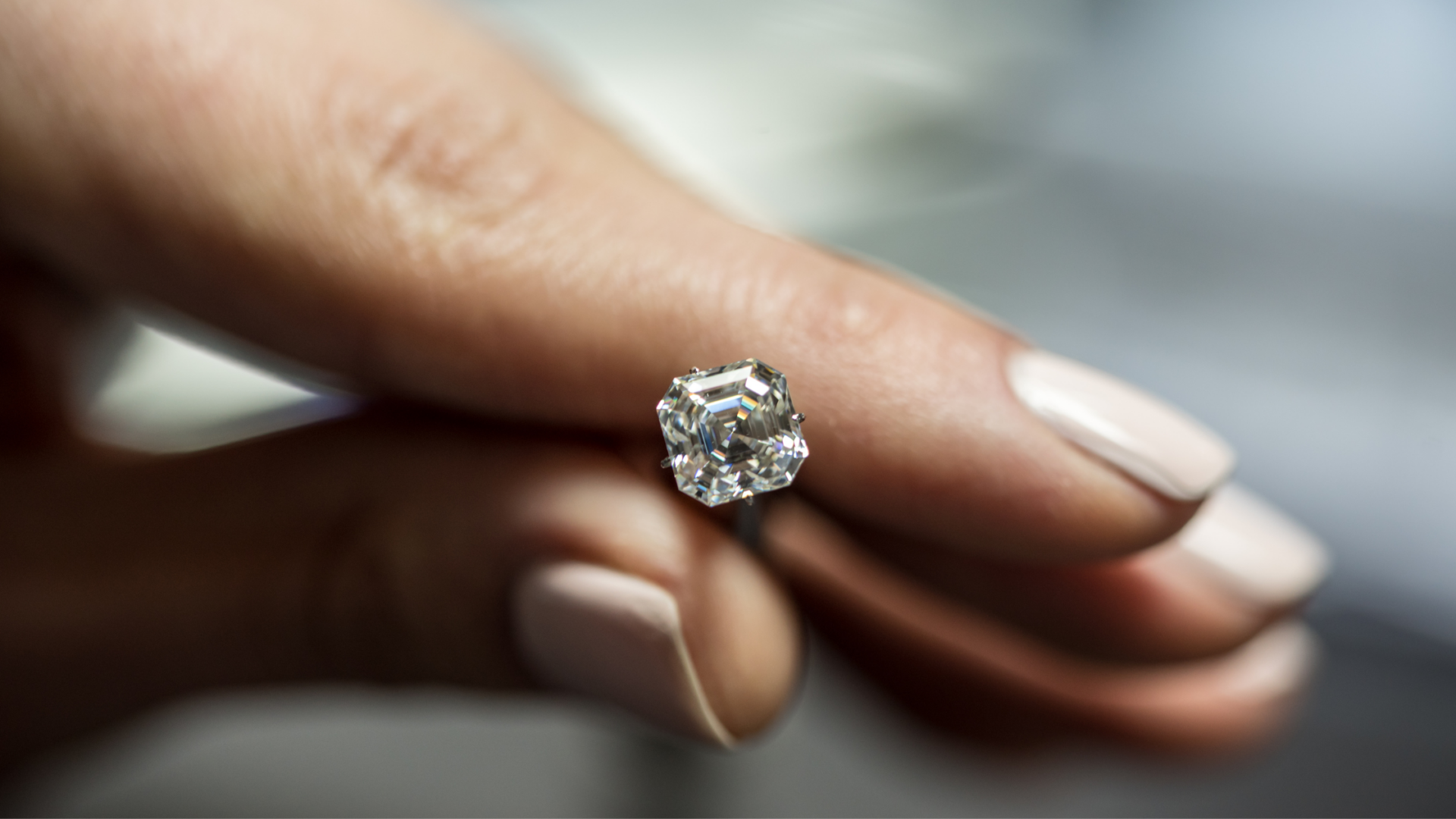You are using an out of date browser. It may not display this or other websites correctly.
You should upgrade or use an alternative browser.
You should upgrade or use an alternative browser.
Swiss cut diamond
- Thread starter Bagpuss
- Start date
- Status
- Not open for further replies. Please create a new topic or request for this thread to be opened.
katbadness
Shiny_Rock
- Joined
- Jan 29, 2004
- Messages
- 480
Bagpuss,
That's a real beauty! I have only seen a couple other picture of diamonds described as Swiss cut, but they don't look like the picture you posted.

The diamonds on the sides of the emerald is supposed to be Swiss cuts.
More pictures can be found on this site --
Nelson Rarities Rings
I'm hoping Oldminer will found this thread and give us his opinion.
That's a real beauty! I have only seen a couple other picture of diamonds described as Swiss cut, but they don't look like the picture you posted.
The diamonds on the sides of the emerald is supposed to be Swiss cuts.
More pictures can be found on this site --
Nelson Rarities Rings
I'm hoping Oldminer will found this thread and give us his opinion.
winyan
Brilliant_Rock
- Joined
- May 9, 2003
- Messages
- 1,163
This is from some guy who did his thesis or dissertation on diamonds ...
Table Cut: It is a rather simple cut: an octahedron with one vertex
truncated to expose a square face, or a table. Introduced in the
early 15th C until mid 17th C, though it was found in Indian and
other native jewelry. This is probably the simplest cut, which is
not too surprising in the view that diamonds are pretty much
impossible to cut and polish with tools available at that time
period.
Rose Cut: AKA the Crowned Rose cut, Full Holland cut, or the Dutch
cut. Looks like a hemisphere, with a flat base. It has polished
flat facets in a regular pattern symmetric about the axis. It
could be as few as 3 facets, as many as 24.
Senaille Cut: Irregularly faceted and shaped Rose cut.
Pichere: Irregularly shaped chips of diamond.
Peruzzi Cut: The first cut that has recognizable facets. Named
after Vincenzio Peruzzi, who was credit for inventing this cut
around 1700. The 56 facets are arranged in a very similar manner
as the modern round cut, but stretched over a differently shaped
stone. It is square, or almost square (instead of round), the
table is small, the culet is large, and has higher crown and deeper
pavilion. Looks like halfway between a table cut and round cut.
Old Mine Cut: You may actually run across this in old jewelry. It
is similar like Peruzzi, but the corners are rounded. Again it has
high crown, deep pavilion, small table compared to the round cut.
Looks like an intermediate between Peruzzi and brilliant.
Cushion Cut: same as the Old Mine Cut, except that is used for
colored stones as opposed to diamonds.
Single Cut: AKA the Eight Cut. Used for stones that too small
(< 5 pts) to be cut into a stone with more facets. It is
approximately the same shape as the brilliant, ignoring the facets:
it is round, has similar crown height, pavilion depth, table size,
small (or no) culet. But the crown is composed of eight
trapezoidal facets, one side of which forms an edge with the table,
the opposite edge is on the girdle, and the two remaining opposite
sides of the equal length form edges with adjacent identical crown
facets. The pavilion facets are just acute isosceles triangles,
with bases on the girdle, and the opposite vertices on the culet.
This makes the total of 16 facets plus a table.
Swiss Cut: Used for smaller stones as well. It is halfway between
the brilliant cut and the single cut. Again, similar dimensions to
the modern cut. The crown has 8 isosceles triangular facets which
have bases on the girdle and apices that form the octagon of the
table, and has another 8 isosceles triangles which have bases on
the table to form edges of the table's octagon and apices on the
girdle. On the other side of the girdle are eight isosceles
triangular facets, which pretty much share the base with the former
crown triangular facets. The rest of the pavilion is taken up by
eight rhomboidal facets, whose two adjacent sides form an edge with
the neighboring identical facets and with the corners between these
two edges forming the culet; the other adjacent sides form an edge
with neighboring aforementioned triangular facets, with the corner
between the two sides on the girdle. That makes it 32 facets, a
culet, and a table.
Native Cut: a nice way of saying an irregularly cut brilliant cut.
win
Table Cut: It is a rather simple cut: an octahedron with one vertex
truncated to expose a square face, or a table. Introduced in the
early 15th C until mid 17th C, though it was found in Indian and
other native jewelry. This is probably the simplest cut, which is
not too surprising in the view that diamonds are pretty much
impossible to cut and polish with tools available at that time
period.
Rose Cut: AKA the Crowned Rose cut, Full Holland cut, or the Dutch
cut. Looks like a hemisphere, with a flat base. It has polished
flat facets in a regular pattern symmetric about the axis. It
could be as few as 3 facets, as many as 24.
Senaille Cut: Irregularly faceted and shaped Rose cut.
Pichere: Irregularly shaped chips of diamond.
Peruzzi Cut: The first cut that has recognizable facets. Named
after Vincenzio Peruzzi, who was credit for inventing this cut
around 1700. The 56 facets are arranged in a very similar manner
as the modern round cut, but stretched over a differently shaped
stone. It is square, or almost square (instead of round), the
table is small, the culet is large, and has higher crown and deeper
pavilion. Looks like halfway between a table cut and round cut.
Old Mine Cut: You may actually run across this in old jewelry. It
is similar like Peruzzi, but the corners are rounded. Again it has
high crown, deep pavilion, small table compared to the round cut.
Looks like an intermediate between Peruzzi and brilliant.
Cushion Cut: same as the Old Mine Cut, except that is used for
colored stones as opposed to diamonds.
Single Cut: AKA the Eight Cut. Used for stones that too small
(< 5 pts) to be cut into a stone with more facets. It is
approximately the same shape as the brilliant, ignoring the facets:
it is round, has similar crown height, pavilion depth, table size,
small (or no) culet. But the crown is composed of eight
trapezoidal facets, one side of which forms an edge with the table,
the opposite edge is on the girdle, and the two remaining opposite
sides of the equal length form edges with adjacent identical crown
facets. The pavilion facets are just acute isosceles triangles,
with bases on the girdle, and the opposite vertices on the culet.
This makes the total of 16 facets plus a table.
Swiss Cut: Used for smaller stones as well. It is halfway between
the brilliant cut and the single cut. Again, similar dimensions to
the modern cut. The crown has 8 isosceles triangular facets which
have bases on the girdle and apices that form the octagon of the
table, and has another 8 isosceles triangles which have bases on
the table to form edges of the table's octagon and apices on the
girdle. On the other side of the girdle are eight isosceles
triangular facets, which pretty much share the base with the former
crown triangular facets. The rest of the pavilion is taken up by
eight rhomboidal facets, whose two adjacent sides form an edge with
the neighboring identical facets and with the corners between these
two edges forming the culet; the other adjacent sides form an edge
with neighboring aforementioned triangular facets, with the corner
between the two sides on the girdle. That makes it 32 facets, a
culet, and a table.
Native Cut: a nice way of saying an irregularly cut brilliant cut.
win
- Status
- Not open for further replies. Please create a new topic or request for this thread to be opened.
Did You Miss the March 2024 Jewels of the Weeks?
Did You Miss the March 2024 Jewels of the Weeks? - 03/30
Did You Miss the Throwback Thursdays for March 2024?
Did You Miss the Throwback Thursdays for March 2024? - 03/28





300x240.png)